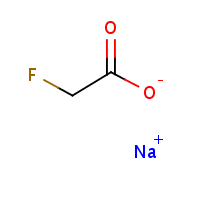Note from FAN: Molecular structure of highly toxic Sodium fluoroacetate (known as 1080)

The Department of Conservation says the animals appear to have entered an operational zone.
Eight cattle found dead in the Waikato appear to have entered a 1080 drop zone through a broken fenceline, the Department of Conservation says.
DOC is investigating the animal deaths following a pest control operation in Mapara, south of Te Kuiti, nearly two weeks ago.
The cattle appeared to have breached a fenceline and entered the Mapara Wildlife Reserve where the poison was dropped on September 6 in an operation targeting rats, stoats and possums.
DOC was now working to establish exactly how the animals came to be in the area, operations director David Speirs said.
READ MORE:
* 1080 operation in northern Remutakas continues despite nationwide protests
* Rats and stoats to be banished from Waiheke Island by 2025
* Letter ‘declares war’ on Department of Conservation over use of 1080
“We have been working closely with the landowner concerned to confirm exactly what happened, and also to support them as any good neighbour would under these circumstances with the burial of the dead animals and we have offered to assist with feed for the remaining animals,” he said
Samples of the dead animals were taken for analysis results were expected within a fortnight.
Prior to this month’s 1080 (sodium fluoroacetate) drop there had been comprehensive consultation with adjacent landowners, DOC said.
Staff had noted stock in the operational area during a pre-flight assessment of the boundary a fortnight before the drop and advised the farmer to move the animals.
The owners of the dead animals, dry stock farmers Paula and Mark Stone, confirmed they were told to move the cattle and had done so.
However, Mark Stone told Radio New Zealand he would never have moved his cattle to the paddock where they eventually died if he had known the area he moved them from would not end up receiving 1080.
He said communication from DOC and the Ministry for Primary Industries had been poor and there had been “a complete breakdown”.
Paula Stone said the cattle had in the past been let into the bush area where the drop occurred but the gate had been secured all winter.
While it was not certain the animals had escaped into the operation area, it was a possibility, she said.
During a boundary walk with DOC staff after the discovery of the dead cattle, damage was discovered on the fence that had been secured.
Paula Stone said they had seen spillage from the 1080 operation in paddocks on the boundary of the drop zone but nothing had been found in the paddock where the cattle died, although it had been 12 days since the drop.
Speirs said a 500kg animal would have to eat 22 or 23 baits to get a lethal dose, but it wasn’t impossible a cow would eat that much. The drop rate was 300 baits per hectare.
A review of the operational data showed the aerial drop went according to plan and as agreed with all landowners bordering the drop zone, he said.
The helicopter GPS flight lines showed there was no over-flight of the adjacent farm area and there was a 50-metre buffer within the operational area in place.
Mapara is home to a nationally important population of North Island k?kako. New Zealand falcon and North Island robin are also found in the reserve.
DOC, Federated Farmers and Forest and Bird all support the use of 1080 but opponents have repeatedly called for it to be banned, claiming it kills native animals and birds and contaminates waterways.
However, supporters say pest numbers are so high that without serious action some native forests and wildlife would be seriously damaged without the use of 1080.
*Original article online at https://www.stuff.co.nz/business/farming/107194718/eight-cattle-dead-after-1080-drop-in-waikato
